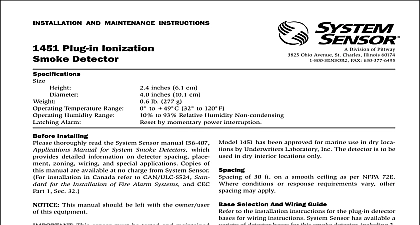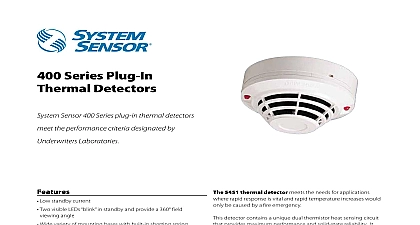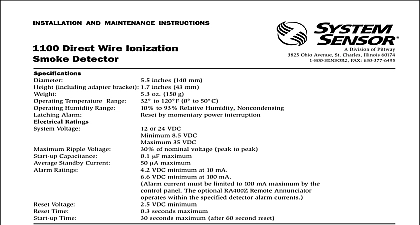System Sensor 100 Series Plug in Smokes

File Preview
Click below to download for free
Click below to download for free
File Data
| Name | system-sensor-100-series-plug-in-smokes-8954130726.pdf |
|---|---|
| Type | |
| Size | 1.37 MB |
| Downloads |
Text Preview
INSTALLATION AND MAINTENANCE INSTRUCTIONS and 1151A Low Profile Plug in Smoke Detectors SENSOR Division of Pittway 3825 Ohio Avenue St Charles Illinois 60174 FAX 630 377 6495 Temperature Range inches 43 mm inches 102 mm oz 102 g to 60 cid 176 C 14 cid 176 to 140 cid 176 F Do not install in locations where normal ambient temperature range extends 0 cid 176 to 49 cid 176 C 32 cid 176 to 120 cid 176 F Humidity Range Alarm to 93 Relative Humidity Noncondensing by momentary power interruption Installing thoroughly read the System Sensor manual I56 407 Manual for System Smoke Detectors which detailed information on detector spacing place zoning wiring and special applications Copies of manual are available at no charge from System Sensor installation in Canada refer to CAN ULC S524 Stan for the Installation of Fire Alarm Systems and CEC 1 Sec 32 This manual should be left with the owner user this equipment The detector used with this base must be and maintained regularly following NFPA 72 require The detector used with this base should be cleaned least once a year Description 1151 and 1151A ionization detectors use state of sensing chambers These detectors are designed to open area protection and to be used with compat UL listed control panels only The capability of plug these detectors into a variety of special bases makes more versatile than equivalent direct wired models LEDs on each detector light to provide a local 360 cid 176 vis alarm indication Remote LED annunciator capability available as an optional accessory These detectors also the latching alarm feature The alarm can be reset by a momentary power interruption For testing these have an internal magnetically activated reed of 30 ft on a smooth ceiling as per NFPA 72 conditions or response requirements vary other may apply Selection and Wiring Guide to the installation instructions for the plug in detector for wiring instructions System Sensor has available a of detector bases for this smoke detector including applications with and without relays and or current resistors 4 wire and 120 VAC applications Note 120 VAC detector base is not available in Canada bases are provided with screw terminals for power remote annunciator connections and relay contact if applicable The electrical ratings for each combination are also included in the base in instructions Manuals Online I56 546 03 All wiring must conform to applicable local codes and regulations Verify that all detector bases are installed that the circuits have been tested and that wiring is correct power from initiating device circuits before install detectors Install Detectors Place the detector into the detector base Rotate the detector clockwise until the detector drops place Continue rotating the detector clockwise to lock it in Tamper Resistance The detector bases include a feature when activated prevents removal of the detector the use of a tool See the installation instruction of the detector base for details in using this fea After all detectors have been installed apply power to control unit Test the detector as described under TESTING Reset the detector at the system control panel Notify the proper authorities that the system is in opera covers are an effective way to limit the entry of dust smoke detector sensing chambers However they may completely prevent airborne dust particles from enter the detector Therefore System Sensor recommends the of detectors before beginning construction or other producing activity sure to remove dust covers from any sensors that were in place during construction as part of returning the to service must be tested after installation and following pe maintenance However before testing notify the authorities that the smoke detector system is under maintenance and the system will be temporarily out service Disable the zone or system undergoing mainte to prevent unwanted alarms addition check to ensure that the LEDs blink If they do power has been lost to the detector check the wiring it is defective return for repair the sensors as follows Test Magnet Model M02 24 optional Test the sensor by positioning the optional test mag against the sensor plastic just to the left of LED1 1 Both LEDs should latch on within 30 seconds indicat an alarm and annunciating the panel 1 Bottom and side views showing position of test magnet Manuals Online I56 546 03 Calibrated Sensitivity Test MOD400R Use the MOD400R Test Module with a digital or analog to test calibrated detector sensitivity as de in the test module manual 2 Aerosol Generator Gemini 501 Set the generator to represent 4 ft to 5 ft obscura as described in the Gemini 501 manual Use the shaped applicator to apply aerosol to the sensor It alarm within 30 seconds the proper authorities that the system is back on Detectors that fail these tests should be cleaned as de under MAINTENANCE and retested If the detec still fail these tests they should be returned for repair cleaning notify the proper authorities that the sys is undergoing maintenance and will be temporarily out service Disable the system to prevent unwanted alarms Remove the sensor to be cleaned from the system Remove the sensor cover Use a small standard screw to release each of four cover removal tabs hold the cover in place Vacuum the outside of the screen carefully without re it Remove the sensor screen Pull the screen straight away the sensing chamber until it snaps out of place Re screens are available Use a vacuum cleaner or clean compressed air to re dust and debris from the sensing chamber Reinstall or replace the sensing chamber screen by slid the edge without the tabs over the sensing chamber sure that one of the Screen Contacts touches the Board Contact Reinstall the sensor cover Use the test module socket LEDs to align the cover with the sensor Snap the into place When all sensors have been cleaned restore power to system and test the sensor s as described in the section of this manual REMOVAL BOARD Manuals Online I56 546 03 Limitations of Property Protection Smoke Detectors smoke detector is designed to activate and initiate emergency ac but will do so only when it is used in conjunction with an authorized alarm system This detector must be installed in accordance with standard 72 detectors will not work without power AC or DC powered detectors will not work if the power supply is cut off detectors will not sense fires which start where smoke does not the detectors Smoldering fires typically do not generate a lot of which is needed to drive the smoke up to the ceiling where the detector is usually located For this reason there may be large de in detecting a smoldering fire with either an ionization type detector a photoelectric type detector Either one of them may alarm only after has initiated which will generate the heat needed to drive the to the ceiling from fires in chimneys in walls on roofs or on the other side of a door s may not reach the smoke detector and alarm it A detector detect a fire developing on another level of a building quickly or at For these reasons detectors shall be located on every level and in bedroom within a building detectors have sensing limitations too Ionization detectors and detectors are required to pass fire tests of the flaming and type This is to ensure that both can detect a wide range of of fires Ionization detectors offer a broad range of fire sensing capa but they are somewhat better at detecting fast flaming fires than smoldering fires Photoelectric detectors s


